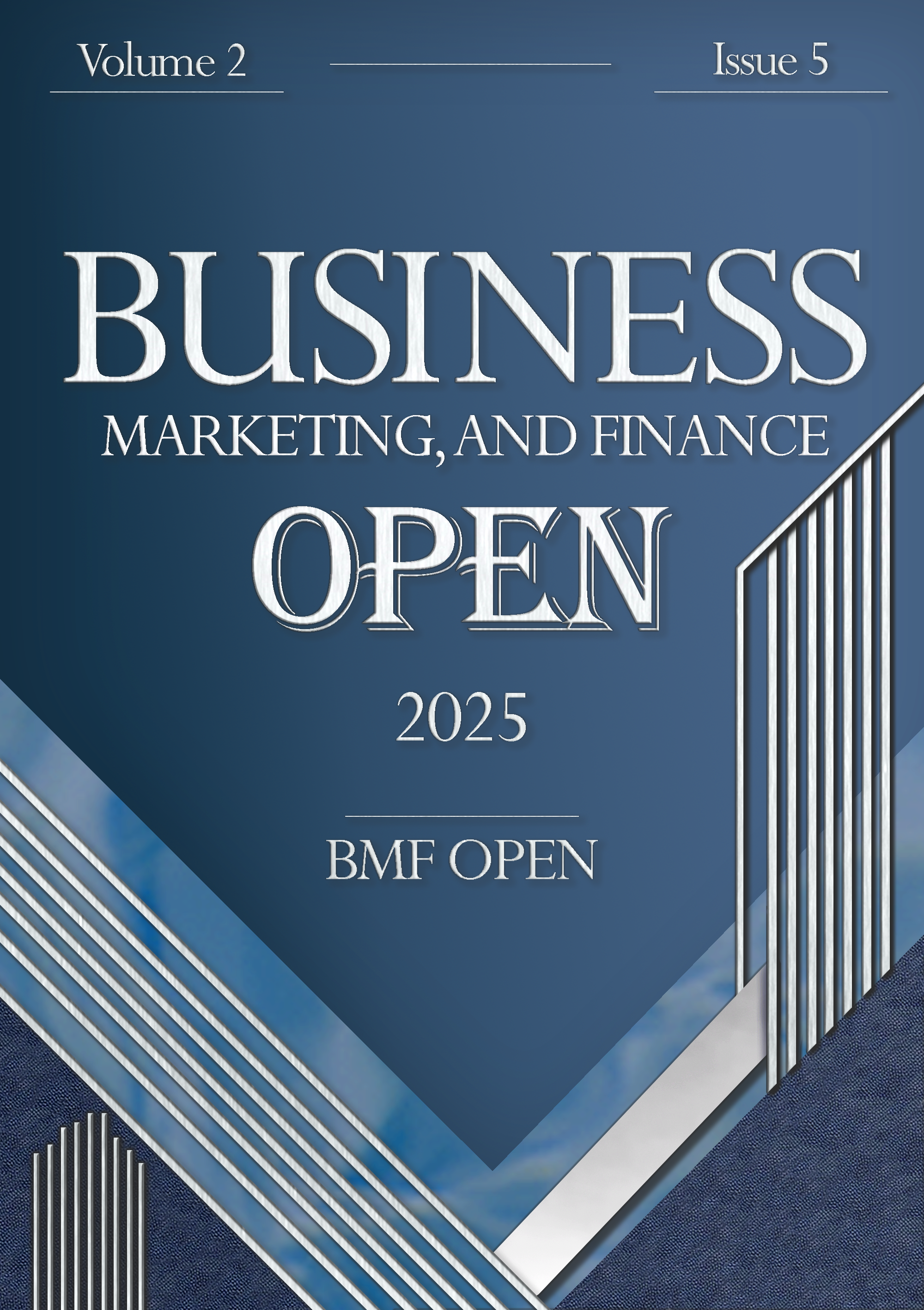Presenting a Coherent Model of Augmented Reality Marketing in Advertising Based on the Meta-Synthesis Approach
Keywords:
Augmented reality marketing, advertising, meta-synthesis, Shannon entropyAbstract
Augmented reality marketing refers to the use of augmented reality in marketing to enhance customer experiences. Augmented reality (AR) has increasingly attracted the attention of both managers and researchers in recent years. AR is a potential technology that enriches consumer experiences and transforms marketing. The purpose of this study is to present a coherent model of augmented reality marketing in advertising based on a meta-synthesis approach. To this end, using a mixed-method research approach and the meta-synthesis tool—which includes the seven-step method of Sandelowski and Barroso (2006)—a systematic evaluation and analysis of the results and findings of prior studies was conducted, ultimately reviewing 43 articles. In the quantitative phase, the Shannon entropy method was used to prioritize the components of the identified themes. Augmented reality was classified into three dimensions: AR characteristics, purchase intention, and subjective norms. The characteristics of AR included the AR mirror, perceived usefulness, emerging brands, and digital transformation; purchase intention included informativeness, usefulness, simplification, and persuasion; and subjective norms included AR acceptance, aesthetics, consumer connection experience, and perceived enjoyment. In total, the contribution of AR characteristics (15%), purchase intention (58%), and subjective norms (27%) to augmented reality marketing was determined. The meta-analysis of this study provides insight into the need to utilize augmented reality in marketing, which proves beneficial for developing marketing strategies.
References
K. Parsakia and M. Jafari, "Strategies for Enhancing Customer Engagement Using Artificial Intelligence Technologies in Online Markets," Journal of Technology in Entrepreneurship and Strategic Management (JTESM), vol. 2, no. 1, pp. 49-69, 05/29 2023, doi: 10.61838/kman.jtesm.2.1.6.
P. Jayaswal and B. Parida, "Past, present and future of augmented reality marketing research: a bibliometric and thematic analysis approach Augmented self - The effects of virtual face augmentation on consumers' self-concept," European Journal of Marketing, vol. 57, no. 9, pp. 2237-2289, 2023, doi: 10.1021 10.1016/j.jbusres.2021.03.026.
M. Chylinski, K. de Ruyter, D. Mahr, and D. I. Keeling, "Let me imagine that for you: transforming the retail frontline through augmenting customer mental imagery ability," J. Retail., vol. 95, pp. 94-114, 2019, doi: 10.1016/j.jretai.2019.03.005.
M. Chylinski, J. Heller, T. Hilken, D. I. Keeling, D. Mahr, and K. de Ruyter, "AR marketing: A technology-enabled approach to situated customer experience," Australas. Mark. J. (AMJ), vol. 28, pp. 374-384, 2020, doi: 10.1016/j.ausmj.2020.04.004.
W. Batat, "How augmented reality (AR) is transforming the restaurant sector: investigating the impact of "Le Petit Chef " on customers' dining experiences," Technol. Forecast. Soc. Change, vol. 172, p. 121013, 2021, doi: 10.1016/j.techfore.2021.121013.
A. Chalimov, "Bringing Augmented Reality to Your Retail App," 2021. [Online]. Available: https://easternpeak.com/blog/bringing-augmented-reality-to-yourretail- app.
S. Eunyoung, Y. Feng, and B. Mueller, "The effects of augmented reality mobile app advertising: Viral marketing via shared social experienceJO - Journal of Business Research The state of AR advertising around the globe: A multi-cultural content analysis," J. Promot. Manag., vol. 122, pp. 75-87, 2021, doi: 10.1016/j.jbusres.2020.08.034 10.1080/10496491.2018.1448323.
B. Zaveri and P. Amin, "Augmented and virtual reality: Future of marketing trends," MANTHAN J. Commer. Manag., vol. 6, pp. 16-25, 2019, doi: 10.17492/manthan.v6i1.182679.
F. Baytar, T. Chung, and E. Shin, "Evaluating garments in augmented reality when shopping online," J. Fashion Market. Manag., vol. 24, pp. 667-683, 2020, doi: 10.1108/JFMM-05-2018-0077ER -.
Z. Du, J. Liu, and T. P. Y. Wang, "Augmented Reality Marketing: A Systematic Literature Review and an Agenda for Future Inquiry," Front. Psychol., vol. 13, p. 925963, 2022, doi: 10.3389/fpsyg.2022.925963.
S. Gatter, V. Hüttl-Maack, and P. A. Rauschnabel, "Can Augmented Reality satisfy consumers' need for touch?," Psychology & Marketing, 2022.
A. R. Philipp, J. B. Barry, M. C. t. Dieck, K. Nina, and J. Timothy, "What is augmented reality marketing? Its definition, complexity, and future," Journal of Business Research, vol. 142, pp. 1140-1150, 2022, doi: 10.1016/j.jbusres.2021.12.084.
H. Qin, D. A. Peak, and V. Prybutok, "A virtual market in your pocket: how does mobile augmented reality (MAR) influence consumer decision making?," J. Retail. Consum. Serv., vol. 58SP - 102337, 2021, doi: 10.1016/j.jretconser.2020. 102337.
P. A. Rauschnabel, "Virtually enhancing the real world with holograms: an exploration of expected gratifications of using augmented reality smart glasses," Psychol. Market., vol. 35, pp. 557-572, 2018, doi: 10.1002/mar.21106.
Z. Vera, M. Martin, and A. R. Philipp, "Beyond the gimmick: How affective responses drive brand attitudes and intentions in augmented reality marketing," Psychology & Marketing, vol. 39, no. 7, pp. 1285-1301, 2022, doi: 10.1002/mar.21641.
M. Wedel, E. Bign'e, and J. Zhang, "Virtual and augmented reality: Advancing research in consumer marketing," International Journal of Research in Marketing, vol. 37, no. 3, pp. 443-465, 2020, doi: 10.1016/j.ijresmar.2020.04.004.
V. Zanger, M. Meißner, and P. A. Rauschnabel, "Beyond the gimmick: How affective responses drive brand attitudes and intentions in augmented reality marketing," Psychology & Marketing, vol. 39, pp. 1285-1301, 2022, doi: 10.1002/mar.21641.
C. Yuan, S. Wang, X. Yu, K. H. Kim, and H. Moon, "The influence of flow experience in the augmented reality context on psychological ownership," Int. J. Advert., vol. 40, pp. 922-944, 2021, doi: 10.1080/02650487.2020.1869387.
K. Chitrakorn, "An Augmented Reality Shopping Boutique Is Here," 2021. [Online]. Available: https://www.voguebusiness.com/consumers/augmentedreality- store-machine-a-institute-of-fashion-design.
F. Bonetti, E. Pantano, G. Warnaby, and L. Quinn, "Augmenting reality:fusing consumers' experiences and interactions with immersive technologies in physical retail settings," Int. J. Technol. Market., vol. 13, pp. 260-284, 2019, doi: 10.1504/IJTMKT.2019.104592.
M. T. Cuomo et al., "Managing omni-customer brand experience via augmented reality: a qualitative investigation in the Italian fashion retailing system The role of augmented reality for experience-influenced environments: the case of cultural heritage tourism in Korea," Qual. Mark. Res., vol. 23, pp. 427-445, 2020, doi: 10.1108/QMR-11-2017-0142 10.1177/0047287517708255.
J. Heller, M. Chylinski, K. A. U. M. D. de Ruyter, and D. I. Keeling, "Touching the untouchable: exploring multi-sensory augmented reality in the context of online retailing," J. Retail., vol. 95SP - 219, p. 234, 2019, doi: 10.1016/j.jretai.2019.10.008.
N. Chung, H. Lee, J. Y. Kim, and C. Koo, "The role of augmented reality for experience-influenced environments: the case of cultural heritage tourism in Korea," J. Travel Res., vol. 57, pp. 627-643, 2018, doi: 10.1177/0047287517708255.
I. P. Tussyadiah, T. H. Jung, and M. C. tom Dieck, "Embodiment of wearable augmented reality technology in tourism experiences," J. Travel Res., vol. 57, pp. 597-611, 2018, doi: 10.1177/0047287517709090.
M. C. tom Dieck, T. H. Jung, and P. A. Rauschnabel, "Determining visitor engagement through augmented reality at science festivals: an experience economy perspective," Comp. Hum. Behav., vol. 82, pp. 44-53, 2018, doi: 10.1016/j.chb.2017. 12.043.
S. Jiang, N. Scott, and L. Tao, "Antecedents of augmented reality experiences: potential tourists to Shangri-La Potatso National Park, China," Asia Pac. J. Tour. Res., vol. 24, pp. 1034-1045, 2019, doi: 10.1080/10941665.2019.1653949.
Z. He, L. Wu, and X. R. Li, "When art meets tech: the role of augmented reality in enhancing museum experiences and purchase intentions," Tour. Manag., vol. 68, pp. 127-139, 2018, doi: 10.1016/j.tourman.2018.03.003.
T. L. Huang, "Psychological mechanisms of brand love and information technology identity in virtual retail environments," J. Retail. Consum. Serv., vol. 47, pp. 251-264, 2019, doi: 10.1016/j.jretconser.2018.11.016.
T. L. Huang and S. L. Liao, "A model of acceptance of augmentedreality interactive technology: the moderating role of cognitive innovativeness," Electron. Commer. Res., vol. 15, pp. 269-295, 2015, doi: 10.1007/s10660-014-9163-2.
T. L. Huang and S. L. Liao, "Creating e-shopping multisensory flow experience through augmented-reality interactive technology," Int. Res., vol. 27, pp. 449-475, 2017, doi: 10.1016/j.ausmj.2020.06.010.
T. L. Huang and B. S. Liu, "Augmented reality is human-like: how the humanizing experience inspires destination brand love," Technol. Forecast. Soc.Change, vol. 170, pp. 120853DO - 10.1016/j.techfore.2021.120853, 2021.
D. Plotkina and H. Saurel, "Me or just like me? The role of virtual tryon and physical appearance in apparel M-retailing," J. Retail. Consum. Serv., vol. 51, pp. 362-377, 2019, doi: 10.1016/j.jretconser.2019.07.002.
T. Hilken, K. de Ruyter, M. Chylinski, D. Mahr, and D. I. Keeling, "Augmenting the eye of the beholder: exploring the strategic potential of augmented reality to enhance online service experiences," J. Acad. Mark. Sci., vol. 45, no. 6, pp. 884-905, 2017, doi: 10.1007/s11747-017-0541-x.
F. D. Davis, R. P. Bagozzi, and P. R. Warshaw, "User acceptance of computer technology: a comparison of two theoretical models," Manag. Sci., vol. 35, no. 8, pp. 982-1003, 1989, doi: 10.1287/mnsc.35.8.982.
J. Kim and S. Forsythe, "Adoption of virtual try-on technology for online apparel shopping," J. Interact. Mark., vol. 22, no. 2, pp. 45-59, 2008, doi: 10.1002/dir.20113.
M. Kim, "Digital product presentation, information processing, need for cognition and behavioral intent in digital commerce," J. Retail. Consum. Serv., vol. 50, pp. 362-370DO - 10.1016/j.jretconser.2018.07.011, 2019.
K. Parsakia, M. Rostami, and S. M. Saadati, "Validity and reliability of digital self-efficacy scale in Iranian sample," Journal of Adolescent and Youth Psychological Studies (JAYPS), vol. 4, no. 4, pp. 152-158, 2023. [Online]. Available: https://journals.kmanpub.com/index.php/jayps/article/view/1151.
H. Toby and G. Harsha, "Novelty Effects in Augmented Reality Advertising Environments: The Influence of Exposure Time and Self-Efficacy," Journal of Current Issues & Research in Advertising, vol. 37, no. 2, pp. 113-130, 2016, doi: 10.1080/10641734.2016.1171179.
P. Kowalczuk, C. Siepmann, and J. Adler, "Cognitive, affective, and behavioral consumer responses to augmented reality in e-commerce: a comparative study," J. Bus. Res., vol. 124, pp. 357-373, 2021, doi: 10.1016/j.jbusres.2020.10.050.
M. Daassi and S. Debbabi, "Intention to reuse AR-based apps: the combined role of the sense of immersion, product presence and perceived realism," Inform. Manag., vol. 58, p. 103453, 2021, doi: 10.1016/j.im.2021.103453.
M. Meißner, J. Pfeiffer, T. Pfeiffer, and H. Oppewal, "Combining virtual reality and mobile eye tracking to provide a naturalistic experimental environment for shopper research," Journal of Business Research, vol. 100, pp. 445-458, 2019, doi: 10.1016/j.jbusres.2017.09.028.
J. Nirma Sadamali et al., "'The persuasion effects of virtual reality (VR) and augmented reality (AR) video advertisements: A conceptual review' Augmented reality in smart retailing: a (n)(A) symmetric approach to continuous intention to use retail brands' mobile AR apps," Journal of Business Research, vol. 160, p. 113739, 2023, doi: 10.1016/j.jbusres.2023.113739 10.1016/j.jretconser.2021.102464.
V. Arghashi, "Shopping with augmented reality: How wow-effect changes the equations!," Electronic Commerce Research and Applications, vol. 54, p. 101166, 2022, doi: 10.1016/j.elerap.2022.101166.
S. M. J. Castillo and E. Bigne, "A model of adoption of AR-based selfservice technologies: a two country comparison," Int. J. Retail Distrib. Manag., 2021, doi: 10.1108/IJRDM-09-2020-0380.
M. Manchanda and M. Deb, "On m-commerce adoption and augmented reality: a study on apparel buying using m-commerce in Indian context," J. Int. Commer., vol. 20, pp. 84-112, 2021, doi: 10.1080/15332861.2020.1863023.
M. Saleem, S. Kamarudin, H. M. Shoaib, and A. Nasar, "Retail consumers' behavioral intention to use augmented reality mobile apps in Pakistan," J. Int. Commer., 2021, doi: 10.1080/15332861.2021.1975427.
A. Srivastava, S. A. Dasgupta, A. Ray, P. K. Bala, and S. Chakraborty, "Relationships between the "Big Five" personality types and consumer attitudes in Indian students toward augmented reality advertising," Aslib J. Inform. Manag., vol. 73, pp. 967-991, 2021, doi: 10.1108/AJIM-02-2021-0046.
X. Zhuang, X. Hou, Z. Feng, Z. Lin, and J. Li, "Subjective norms, attitudes, and intentions of AR technology use in tourism experience: the moderating effect of millennials," Leisure Stud., vol. 40, pp. 392-406, 2021, doi: 10.1080/02614367.2020. 1843692.
X. Han, F. Wang, S. Lv, and W. Han, "Mechanism linking AR-based presentation mode and consumers' responses: a moderated serial mediation model," J. Theor. Appl. Electron. Commer. Res., vol. 16, pp. 2694-2707, 2021, doi: 10.3390/ jtaer16070148.
S. H. Y. Hsu, H. T. Tsou, and J. S. Chen, ""Yes, we do. Why not use augmented reality?" customer responses to experiential presentations of ARbased applications," J. Retail. Consum. Serv., vol. 62, p. 102649, 2021, doi: 10.1016/j.jretconser. 2021.102649.
J. B. Whang, J. H. Song, B. Choi, and J. H. Lee, "The effect of augmented reality on purchase intention of beauty products: the roles of consumers' control," J. Bus. Res., vol. 133, pp. 275-284, 2021, doi: 10.1016/j.jbusres.2021.04.057.
J. B. Barhorst, G. McLean, E. Shah, and R. Mack, "Blending the real world and the virtual world: exploring the role of flow in augmented reality experiences," J. Bus. Res., vol. 122, pp. 423-436, 2021, doi: 10.1016/j.jbusres.2020.08.041.
V. Saprikis, G. Avlogiaris, and A. Katarachia, "Determinants of the intention to adopt mobile augmented reality apps in shopping malls among university students," J. Theor. Appl. Electron. Commer. Res., vol. 16, pp. 491-512, 2021, doi: 10.3390/jtaer16030030.
X. Wu and I. K. W. Lai, "The acceptance of augmented reality tour app for promoting film-induced tourism: the effect of celebrity involvement and personal innovativeness," J. Hosp. Tour. Technol., vol. 12, pp. 454-470, 2021, doi: 10.1108/ JHTT-03-2020-0054.
M. Park and J. Yoo, "Effects of perceived interactivity of augmented reality on consumer responses: a mental imagery perspective," J. Retail. Consum. Serv., vol. 52, p. 101912, 2020, doi: 10.1016/j.jretconser.2019.101912.
H. Str¨omberg, O. Rexfelt, I. C. M. Karlsson, and J. Sochor, "Trying on change - trialability as a change moderator for sustainable travel behaviour," Travel Behaviour and SocietyVL - 4, pp. 60-68, 2016, doi: 10.1016/j.tbs.2016.01.002.
A. R. Smink, E. Reijmersdal, G. V. Noort, and P. C. Neijens, "Shopping in augmented reality: the effects of spatial presence, personalization and intrusiveness on app and brand responses," J. Bus. Res., vol. 118, pp. 474-485, 2020, doi: 10. 1016/j.jbusres.2020.07.018.
G. McLean and A. Wilson, "Shopping in the digital world: examining customer engagement through augmented reality mobile applications," Comp. Hum. Behav., vol. 101, pp. 210-224, 2019, doi: 10.1016/j.chb.2019.07.002.
M. M. Paulo, P. Rita, T. Oliveira, and S. Moro, "Understanding mobile augmented reality adoption in a consumer context," J. Hosp. Tour. Technol., vol. 9, pp. 142-157, 2018, doi: 10.1108/JHTT-01-2017-0006.
C. Flavi'an, S. Ib'a˜nez-S'anchez, and C. Orús, "The impact of virtual, augmented and mixed reality technologies on the customer experience," Journal of business research, vol. 100, pp. 547-560, 2019, doi: 10.1016/j.jbusres.2018.10.050.
A. Poushneh, "Augmented reality in retail: a trade-off between user's control of access to personal information and augmentation quality," J. Retail. Consum.Serv., vol. 41, pp. 169-176, 2018, doi: 10.1016/j.jretconser.2017.12.010.
A. Poushneh and A. Z. Vasquez-Parraga, "Discernible impact of augmented reality on retail customer's experience, satisfaction and willingness to buy," J. Retail. Consum. Serv., vol. 34, pp. 229-234, 2017, doi: 10.1016/j.jretconser.2016.1 0.005.
M. Y. C. Yim and S. Y. Park, "I am not satisfied with my body, so I like augmented reality (AR)," J. Bus. Res., vol. 100, pp. 581-589, 2019, doi: 10.1016/j.jbusres.2018.10.041.
T. Zhang, W. Y. C. Wang, L. Cao, and Y. Wang, "The role of virtual tryon technology in online purchase decision from consumers' aspect," Int. Res., vol. 29, pp. 529-551, 2019, doi: 10.1108/IntR-12-2017-0540.
G. Bonnin, "The roles of perceived risk, attractiveness of the online store and familiarity with AR in the influence of AR on patronage intention," J. Retail. Consum. Serv.VL - 52, p. 101938, 2020, doi: 10.1016/j.jretconser.2019.101938.
A. Jessen, T. Hilken, M. Chylinski, D. Mahr, J. Heller, and D. I. Keeling, "The playground effect: how augmented reality drives creative customer engagement," J. Bus. Res., vol. 116, pp. 85-98, 2020, doi: 10.1016/j.jbusres.2020.05.002.
Downloads
Published
Submitted
Revised
Accepted
Issue
Section
License
Copyright (c) 2025 Business, Marketing, and Finance Open

This work is licensed under a Creative Commons Attribution-NonCommercial 4.0 International License.







